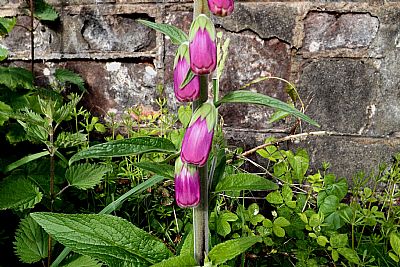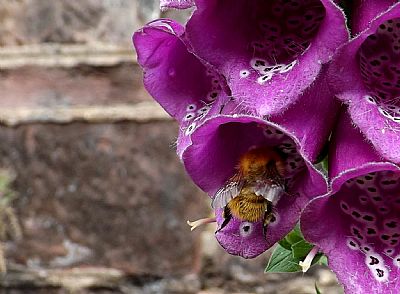FOXGLOVE : Digitalis purpurea
If we worried a lot about the safety of certain flowers in our gardens, the foxglove would be on that list. The Woodland Trust opens its section on this flower with Beautiful but deadly. This familiar flower has the power to cure and kill.
It is found in many a garden, most likely from natural seeding, but also occurs in muirlands and the edges of woods. It produces a tall spike of flowers in late summer. These are much appreciated by bees. Its leaves are oval-shaped and hairy with a errated egde. Its many seeds develop in a capsule which becomes black when ripening.
[Not to be confused with: common comfrey (Symphytum officinale)].
This pretty flower is also a valuable source of nectar for bees.
Fruit/seeds: a capsule encompassing many seeds, which changes colour from green to black when ripening.
While its pollen is a great source of sustainance for insects, the plant itself is poisonous. Foxglove contains a chemical called digitalis that can be used to treat heart failure and high blood pressure by raising blood flow and increasing the body’s defence mechanisms. However, the plant is poisonous if consumed directly, and can cause a number of health problems. So simply don't go around nibbling it.
The Woodland Trust tells us about its associated folklore. The origins of the name foxglove are unclear, but can be traced all the way back to the Anglo-Saxon period. It’s thought the ‘glove’ part of the name is simply due to the flowers looking like glove fingers. Less certain is the connection to foxes. One theory is that people believed foxes wore the flowers on their paws to silence their movements when hunting. Another is that the flower is often found growing close to the earths where foxes raise their young.
The species digitalis is native to Europe, western Asia, and northwestern Africa. introduced species and hybrids may also be found in the UK. In fact the RHS happily describes several of them and how to grow them.

The flowers develop through May.

In a wild habitat the foxgloves reach up and out from amongst other plants.

So what do they look like to you? Fairy caps, fairies thimbles or fairies glove? Or perhaps witches gloves or dead men's bells? Why fox's gloves?
A foxglove gets help with polination from a bumble bee. Note how the spots within each flower have become more dramatic - and perhaps more attractive to bees. The flowers themselves also have hairs which may stimulate the bees and collect pollen from other plants.

While purple predominates, you can find many beautiful white ones too.

Foxgloves come in many colours, but anything other than purple and white or perhaps a pinky variation, are bred versions. So why then do we suddenly find those with mixed colurs on the same plant in mid June? Discussion on the internet asserts that a plant can only produce a single colour although its seeded offspring can vary from the parent plant. Are the greenish yellow upper buds simply not a mature colour? Or are insects mixing up the inherent colours through cross pollination? Or for a 3rd theory - has the extremely hot weather of the preceeding week affected the colouration process? This example taken on the upper Leven towpath is not unique. Similar flowers have been seen all of the area, even some miles away, just at the same time.

Each life-stage is significant.

Its glory days waning, a foxglove slumps, but its seed heads have formed and are soon ready for dispersal.

No longer upright or bright purple or white, but they still look attractive for a while.
RHS / ROYAL HORTICULTURAL SOCIETY : https://www.rhs.org.uk/plants/foxglove
WIKIPEDIA : https://en.wikipedia.org/wiki/Digitalis
WOODLAND TRUST : https://www.woodlandtrust.org.uk/trees-woods-and-wildlife/plants/wild-flowers/foxglove/

